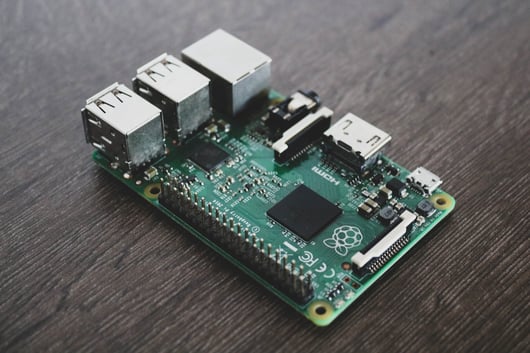The Global Semiconductor Crisis
Welcome back to ClearView Blog. Over the next few articles, we will be discussing the important current machine vision trends, not just thinking about technological advancement, but also focusing on global factors that are impacting the world of machine vision and the industries we support.
This week we will be exploring the many factors that have contributed to the global shortage of semiconductors, which has so far overshadowed Machine Vision growth in the 2020s.
Introduction
We are in unprecedented times. The COVID-19 pandemic has changed how we live and created a new normal for us all.

But what does this mean for the massive global shortage of semiconductor chips? When will we start to see increased supplies relieve the chokehold of peaking demand? What are the many factors in play that help us predict the future and paint a picture of the machine vision world of tomorrow? And the question on everybody’s lips: when will lead times for machine vision components come back down to where they were?
Let’s start with the basics.
What are Semiconductors?
In simple terms, semiconductors are materials like silicon that can be manipulated to either insulate or conduct electricity. This makes them ideal for use as the ‘brains’ in logic boards, as circuits comprising small semiconductor switches, called transistors, lie at the heart of computer chips.

Logic boards like this will always feature semiconductor chips.
The ability to exploit the conductivity of these materials facilitates their capacity to perform mathematic algorithms and run computer programs. By grouping transistors together, logic gates can be formed, which are a fundamental building block of FPGAs (Field Programmable Gate Arrays). These are used often in smart cameras and edge computing, which are fast-growing areas of Industry 4.0 and popular in factory automation.
The Semiconductor Boom/Bust Cycle
These chips are used in a huge range of electronics, for example cars, mobile phones, smart watches, tablets, personal computers – the list goes on. As technology for all these applications becomes more advanced, and as digital computing is being applied to new industries every year, the global demand for these chips continues to surge in the face of extremely constrained supply.
![]()
The boom and bust cycle of the global semiconductor industry is as follows:
- The pace of demand gets faster and faster, catching up with supply. This causes the prices to rise.
- Manufacturers scramble to increase production capacity to take advantage of these high prices.
- With increased capacity now in place, supply starts to outstrip demand, forcing prices to tank.
- As the profitability of continued growth in production capacity wanes, manufacturers ease off and let demand catch up.
This takes us back to phase 1 of the cycle.
To avoid getting bogged down in the economics of the global semiconductor industry, we
suggest watching the above video for an informative and in-depth look at the topic.
The Current Situation in the Semiconductor Industry
As of March 2022, the world is still facing a prolonged and harsh shortage of semiconductor chips.
Despite the situation going on since the start of 2020, we are still waiting for the relieving effects of increased production capacity from manufacturers.
Why is There Still a Shortage of Semiconductors?
There are more factors in play that make this current cycle particularly harsh, not just for end users and system integrators, but for distributors, suppliers, and OEMs too. We must look at these factors to determine why there is still a shortage of semiconductors, and why this still may go on for some time. While there are many factors in play, the key aspects affecting the current situation are:

1. The Effect of COVID-19 Coronavirus on the Global Semiconductor Industry
When the global COVID-19 pandemic struck in 2020, most people predicted that the world would fall into a prolonged recession. Factories closed in efforts to stop the spread of the virus, and production ground to a halt. Anticipating a huge plummet in demand for semiconductors, manufacturers accordingly reduced their capital expenditure, definitively capping production capacity.
What they failed to anticipate, along with most others, was that national lockdowns were the perfect storm for home working to become the new normal.
This resulted in a steep rise in demand for personal computers; so steep that the resulting chip shortage is still affecting many aspects of the economy today. This is due in no small part to the incredibly vast plethora of products that rely on these semiconductors.
China’s Race to Hold Semiconductor Stock
The rate of semiconductor production and trade has skyrocketed since the start of 2020. Companies are scrambling to achieve ‘semiconductor independence’ and possess their own means of chip production. 2020 saw over 22,000 new semiconductor companies registered in China, according to data firm Qichacha. In the first two months of 2021, there were 4,350 more.

Those that haven’t focused on producing their own semiconductors have been buying up semiconductors in large quantities to stave off shortages. According to Protocol, China imported $350 billion worth of chips in 2020, accounting for one-sixth of total imports. ‘China can mass-produce almost anything’, their article states, ‘but microchips, especially high-end ones, are still beyond its reach.’
When Will Semiconductor Supply Relieve Demand?
So we know that producers of semiconductors are now scrambling to increase capacity.
Intel is reportedly spending $20 billion on new plants that will take advantage of the current high prices. The Taiwan Semiconductor Manufacturing Company – the world’s largest annual producer of semiconductors – is also planning to spend $44 billion on expanding their capacity this year.
Increased production capacity for semiconductors is now regarded as a top priority not just for manufacturers, but for many governments as well.
Moreover, the U.S. government is planning to spend $52 billion on subsidies for a nationwide program to boost semiconductor manufacturing, and China is doing the same with around $33 billion in subsidies to bolster domestic chip production.
Previous estimates for a much-needed supply increase had been late 2021; current estimates now suggest that the semiconductor shortage could last until mid to late 2022, or possibly even Q1 2023.
The Future of the Semiconductor Industry’s Boom/Bust Cycle
As governments are now focusing their attention – and money – on increasing semiconductor production, we are likely to start seeing steeper and more dramatic swings up and down in both price and supply.
The present goal is to solve the current bottlenecks in supply, and maximise industrial output. But with huge increases in production, combined with masses of home workers now returning to their offices and no longer buying up PCs at such dramatic rates, demand is sure to drop significantly and the price will plummet, perhaps even more steeply than ever seen before.
The Semiconductor Shortage and Machine Vision
Unfortunately, all of the above issues discussed impact the industrial world just as much as the consumer world.
At the opening of the VISION 2021 trade show in Stuttgart, Mark Williamson, chairman of the board of VDMA Machine Vision opened the event by saying the following:
"The monthly VDMA order intake and turnover statistics show that the order books of the machine vision industry are full to the brim. The demand for machine vision components and systems remain very high, however, companies are struggling to keep up with production due to the shortage of materials especially electronic components and therefore are having to reduce their current production plans.”
What Can You Do To Help?
Whilst the supply chain sorts itself out, the key is to be as flexible as possible. If there is specific hardware you need that has a very long lead time still, it is always worth speaking with us so we can understand if there are alternatives available sooner that will still suit your needs.

Our machine vision experts are on hand to help you
This situation is encouraging us all to learn how we can improve our portion of the logistical pipeline. It’s helping us learn how best to forward plan our hardware requirements for our customers, and this only improved by our customers forward planning their own requirements as soon as possible.
Let us know your needs – the earlier the better. This will always help, as we can feed this information into our own stock planning in order to mitigate lead time issues.
Conclusion
Because there are so many far-reaching considerations regarding the topical intersection of geopolitics, global economics, and semiconductors, it is incredibly hard to cover everything in one blog post. Due to this incredibly complex situation, it’s hard to be precise when predicting the future – experts are saying we will have to wait until around the end of 2022 or possibly as far away as early-mid 2023 before we start to feel the benefit of increased supplies.
Until then, let us help you by working with us to find the best solution for your project. Our machine vision expertise and wide range of products are what separate us from the crowd; we might be the difference between waiting out your quoted lead time and finding you an alternative that gets to you sooner.
We’re currently working hard with our suppliers to mitigate lead times and provide workarounds in the meantime.
Thanks for reading – we hope everyone stays safe and we wish all the best to our customers as 2021 Q4 draws to a close.
Machine Vision Solutions from ClearView Imaging
Want to find out more about revamping your vision system or automating your industrial processes? Look no further – get in touch with us.
Also, be sure to check out our great range of machine vision components over in our products section!
Here at ClearView, we have a broad range of knowledge and machine vision expertise to help you decide on the right solution for your project.
We offer friendly expertise and a huge range of industry-standard quality machine vision components for printing and packaging, robotics, industrial automation, medicine, life sciences, and the automotive industry, just to name a few.
Our experts are happy to help no matter what your question or problem may be. Feel free to get in touch with us and one of our machine vision experts will be ready to help you get going with your project!








